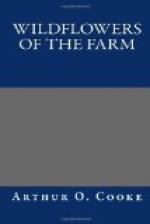We saw that the Poppy and the Pimpernel were the only two true scarlet wild flowers of our fields. In the same way there is only one other English wild flower which has such a deep blue blossom as the Alkanet. That is the Borage; and the Borage, like the Alkanet, is not really a native of England. For a fine golden yellow flower I do not know anything which can beat the Dandelion. If we have not seen every wild flower which grows at Willow Farm, we have at any rate seen three which have the deepest and richest colours.
Now for my next favourite. This time we go to the shady lane leading from Willow Farm to the church; that is the only place near here where I have found the Lesser Periwinkle. There is also a Larger Periwinkle, very similar to my favourite here, except in size.
[Illustration: LESSER PERIWINKLE.]
To find the Periwinkle in full flower we should have to come in spring, but, though it is July now, we shall still find a blossom here and there, I hope. Even in winter we might do so too.
The Lesser Periwinkle has a blue flower, but the blue is a pale lilac blue. Here again the petals are really the five spreading lobes of the corolla. There is something curious about these lobes. They are of a peculiar irregular shape that is not easy to describe; they are not exactly pointed, and they are not regular in shape. You could cut the petal of a Buttercup into two equal parts; it would be almost impossible to do this with the lobes of the Periwinkle blossom.
The leaves are dark green, glossy and pointed, and they grow in pairs. Often, however, we find two pairs of leaves growing so closely together that they seem to grow in fours. The leaves are evergreen; they do not fade and die in autumn.
Some of the Periwinkle stems are erect and are about six inches high; others are creeping. It is only the erect stems which bear flowers; the creeping ones are barren. They do useful work, however, for they form fresh roots, as we have seen the stalks of some other plants do. In this way the whole bank beside the lane has become covered with the pretty plant.
The Periwinkle is a comparatively small plant. The last flower—the Foxglove—that we shall see at Willow Farm is quite different. It is a very tall plant. It is generally described as growing from three to five feet high, but I have seen a stem of eight or nine feet. We shall find it growing on the hedgebank in Little Orchard, and it also often grows in woods.
Some plants, as we know, are annuals, others are perennials. The Foxglove is neither; it is a biennial—that is a two years’ plant. If you sow Foxglove seed you will have no flowers the first year, only a root and a great bunch of leaves. In the second year tall stems which bear the flowers will appear. In the autumn after it has flowered the Foxglove generally dies, though sometimes it may live for another year, or even two. Foxgloves, of course, will reproduce themselves by seed, as annuals and perennials do.




